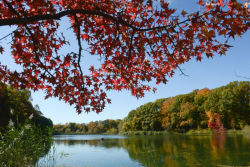Alley Pond Park
Freshwater Wetlands in New York City - Alley Pond Park
New York City once contained 224,000 acres of freshwater wetland. This valuable ecosystem can slow erosion, prevent flooding by retaining storm waters, filter and decompose pollutants, and slow global warming by converting carbon dioxide into oxygen at a prodigious rate. In the past 200 years, the increasing demands of a growing metropolis have resulted in most of this land being filled for construction, or dredged for transport. Only 2,000 acres of freshwater wetland remain in the city today, and many species that once called the wetland home have been lost forever.
Alley Pond Park, the second-largest park in Queens, lies on a glacier-formed moraine – a ridge of sand and rock that formed 15,000 years ago. The glacier, which dropped the boulders that sit on the hillsides of the park’s southern end, also left buried chunks of ice that melted and formed the ponds dispersed throughout the Alley, the 150-acre strip of wetlands in the north end of the park. Freshwater drains into the Alley from the hills and bubbles up from natural springs, mixing with the saltwater from Little Neck Bay. As a result, Alley Pond Park is host to freshwater and saltwater wetlands, tidal flats, meadows, and forests, making for a diverse ecosystem and supporting abundant bird life
The formation of wetlands can be traced back to the most recent ice age. A massive ice sheet called the Wisconsin Glacier advanced on New York City 75,000 years ago, pushing rock, soil, and boulders ahead. When the ice melted 17,000 years ago, water flowed to the sea, creating streams and rivers that carved through rock. Large glacial fragments broke off, melted, and left depressions called kettles. If layers of fine silt and clay were deposited on the bottom of the depressions, the kettles collected water and ponds formed. Where waters were shallow or flowed slowly, seeds and spores were able to take root and flourish. Generations of plants grew and decomposed, building peat-rich sediments. As wind and water eroded the soil, the steep slopes grew gentler, slowing the passage of water. Plant communities diversified under these favorable conditions, attracting animals that fed on the plants. The sophisticated food web that developed brought advanced predators to the wetlands: snapping turtles (Chelydra serpentina), wolves (Canis lupus), several species of hawks, and humans (Homo sapiens).
Water levels in wetlands are variable, influenced by the underlying rock and soil makeup, rainfall, season, and ground water inputs. Despite these variable conditions, freshwater wetlands teem with life. At Cattail Pond, near the Alley Pond Environmental Center, robust cattails (Typha latifolia) have almost closed the open water. Only when muskrats (Ondatra zibethica) swim through the duckweed, to feed on their roots, does the water clear to reveal the killifish (Fundulus heteroclitus) swarming below. The pond is the lowest-lying point in a cattail marsh, which stretches for acres, punctuated by water plantain (Alisma subcordatum) and arrow arum (Peltandra virginica). The boardwalk protects fragile plants from trampling. Marsh St. John’s wort (Hypericum virginicum) and swamp milkweed (Asclepias incarnata) bloom in this meadow, which is filled with toad and turtle tracks.
Lily Pad and Decodon Ponds, the deep and steep-sided kettle ponds of the southern section, have grown shallow and rich in plant life. Erosion of their slopes has made them nutrient-rich and a floating mat of swamp loosestrife (Decodon verticillatus) occupies almost all the open water. As swamp loosestrife grows, it loops up and back down, forming a mat on which new seedlings can develop. While the larger Turtle Pond retains areas of open water around its loosestrife mat, the water is still shallow and warm enough to allow the yellow-flowered common bladderwort (Utricularia vulgaris) and floating duckweed (Lemna minor) to flourish. A few carp and minnows live in the pond. Mallards (Anas platyrhychos) nest in swamp loosestrife and wood ducks (Aix sponsa) find shelter in the dead trees of the upland swamp forest. In addition to housing these native species, freshwater wetlands also provide resting, breeding, and feeding grounds for hundreds of thousands of migrating birds. Many of these birds arrive in New York City only twice a year as they travel along the Atlantic flyway, a major migratory route.
Check out your park's Vital Signs
Clean & Safe
Green & Resilient
Empowered & Engaged Users
Share your feedback or learn more about how this park is part of a
Vital Park System










